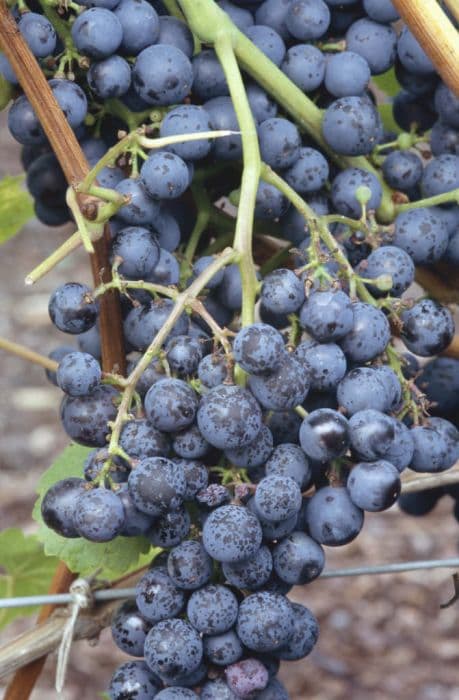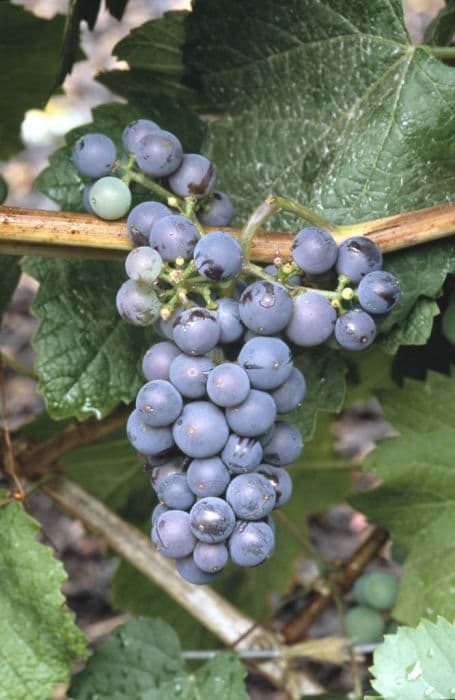Léon Millot grape Vitis 'Léon Millot' (O/g/b)

ABOUT
The Vitis 'Léon Millot', commonly known as the 'Léon Millot' grapevine, is a cultivated vine that is appreciated for its fruiting capabilities, particularly in winemaking. This plant typically displays a robust and sprawling growth habit, characterized by its woody vines that spiral and climb, seeking support to anchor their weight. The vines themselves are covered with a rough, bark-like texture which can range in color from greyish to brown tones. The leaves of the 'Léon Millot' grapevine are broad and deeply lobed, exhibiting a vibrant green color that can transition to more golden or reddish hues as the seasons change. Each leaf is veined distinctly, with a somewhat leathery feel and serrated edges, providing a lush and full appearance across the length of the vines. Clusters of grapes that this vine produces are typically compact and cylindrical, hanging gracefully from the vine in groupings. These grapes are renowned for their dark blue to nearly black skin when fully ripe, covered in a waxy bloom that gives them a characteristic powdery look. The flesh within is juicy and sweet, often used in wine production for its desirable flavor profile. Flowers of the 'Léon Millot' are less noticeable in comparison to its striking foliage and fruit. These small, inconspicuous blooms are greenish-white and gather in clusters. They eventually give way to the bunches of grapes that are the highlight of this plant's appearance. Overall, the 'Léon Millot' grapevine is admired for its fruiting ability and the ornamental quality of its leafy, vine-covered aesthetic, which adds both greenery and charm to the environments it is grown in.
About this plant
 Names
NamesSynonyms
Léon Millot, Millot
Common names
Vitis 'Leon Millot'.
 Toxicity
ToxicityTo humans
Vitis 'Léon Millot', commonly known as the grape, is generally not toxic to humans when consumed in the form of ripe grapes or grape products. However, all other parts of the grapevine, including leaves, stems, and especially seeds, can potentially cause adverse effects if ingested in large quantities. Symptoms of grape toxicity, although rare in humans, can include stomach upset, nausea, vomiting, and diarrhea. It's worth noting that in very large doses, other parts of the plant might lead to more severe reactions due to the presence of tannins and other compounds.
To pets
Grape, including Vitis 'Léon Millot', is highly toxic to some pets, especially dogs. Symptoms of grape poisoning in pets can include vomiting, diarrhea, lethargy, abdominal pain, dehydration, and lack of appetite. In severe cases, ingestion can lead to acute kidney failure, which can be fatal if not treated promptly. Even small amounts of grapes can be dangerous to dogs, so any ingestion should be taken seriously and warrants immediate veterinary attention.
 Characteristics
CharacteristicsLife cycle
Perennials
Foliage type
Deciduous
Color of leaves
Green
Flower color
Green
Height
5 feet (1.5 meters
Spread
10 feet (3 meters
Plant type
Climber
Hardiness zones
5
Native area
Europe North America
Benefits
 General Benefits
General Benefits- Attractive Foliage: Adds visual interest to landscapes with its lush green leaves.
- Fruit Production: Yields grapes that can be used for jelly, juice, or winemaking.
- Wildlife Attraction: Attracts birds and wildlife that feed on the grapes.
- Shade Provider: Can be trained over pergolas or trellises to provide shade in gardens and patios.
- Seasonal Interest: Offers seasonal color changes, especially in fall when leaves may turn vibrant colors.
- Erosion Control: Vigorous growth habit can help stabilize soil and prevent erosion on slopes.
- Cultural Significance: May have cultural value for wine enthusiasts and in regions with winemaking traditions.
- Adaptability: Tolerant of a range of soil types, though it prefers well-drained soil.
 Medical Properties
Medical PropertiesThis plant is not used for medical purposes.
 Air-purifying Qualities
Air-purifying QualitiesThis plant is not specifically known for air purifying qualities.
 Other Uses
Other Uses- Vitis 'Léon Millot', also known as Leon Millot grapes, can be used to create natural dyes for fabrics, offering hues ranging from pale yellows to deep purples depending on the mordant used.
- The vines of Leon Millot grapes can be woven into wreaths and other decorative items, providing a rustic and sustainable crafting material.
- When dried, the grapevine tendrils can be used as ornamental additions to floral arrangements, adding a unique twist to traditional bouquets.
- The leaves of the Leon Millot grape can be utilized in culinary practices, such as a natural wrapper for grilling delicate foods like fish or as containers for rice and meat in dishes similar to Greek dolmas.
- The grape pomace, a by-product of winemaking, can be composted or used directly as a nutrient-rich mulch in the garden, benefiting other plants' growth.
- Grape canes pruned from Leon Millot vines during the dormant season are suitable for crafting eco-friendly drinking straws, which are biodegradable and minimize plastic waste.
- Leon Millot grape skins, rich in color and tannins, can serve as a natural preservative for wood, create a stained finish on furniture, or rejuvenate the color of old wood surfaces.
- In artistic mediums, the juice or concentrates from Leon Millot grapes can be mixed with paints or inks to add natural pigments, giving artists an eco-friendly option for their work.
- The sturdy vine wood from old Leon Millot grapevines can be repurposed into small furniture pieces or carved into kitchen utensils like spoons or bowls.
- When intentionally dried, the vine cuttings of the Leon Millot grape can be used as a natural fuel source for barbecues or smokers, infusing the food with a subtle grapevine flavor.
Interesting Facts
 Feng Shui
Feng ShuiThe grapevine is not used in Feng Shui practice.
 Zodiac Sign Compitability
Zodiac Sign CompitabilityThe grapevine is not used in astrology practice.
 Plant Symbolism
Plant Symbolism- Fertility: The Vitis 'Léon Millot', commonly known as grapevine, bears fruit that is often associated with fertility and abundance due to its clustered growth and plentiful harvest.
- Prosperity: In many cultures, grapevines are a sign of prosperity because vineyards can be highly profitable and the fruit is valuable for the production of wines and other goods.
- Vitality: As a plant that thrives with robust energy, vines symbolize vitality and the vigor of life, as they quickly cover structures and landscapes.
- Transformation: Grapes go through a transformation to become wine, which is a process rich in symbolic meaning, often associated with the transition from the mundane to the exceptional.
- Intoxication: The intoxicating effects of wine made from grapes are symbolic of ecstasy, celebration, and a loss of inhibition.
- Rebirth: Vines die back in winter and regrow in spring, symbolizing rebirth and the cycle of life and nature's resilience.
- Christianity: Within the Christian tradition, the grapevine is a symbol of the blood of Christ and the Eucharist, representing sacrifice and spiritual nourishment.
 Water
WaterFor a mature Leon Millot grapevine, deep waterings are recommended as opposed to frequent shallow waterings to encourage strong root development. During the growing season, it's typically advised to water with about 1 gallon per week, but this can vary based on weather conditions, soil type, and plant size. If the weather is particularly hot or dry, increase watering slightly. Reduce the amount of water as the plant goes dormant in fall, and if you receive regular rainfall, you might not need to water at all. It's important to water the soil directly rather than spraying the foliage to prevent fungal diseases.
 Light
LightLeon Millot grapevines require full sun to produce the best fruit. The ideal spot for planting them is a location where they can receive a minimum of 6 to 8 hours of direct sunlight each day. Avoid spots that are shaded for long periods, as this can impact the vine's fruit production and overall health. An open southern exposure usually provides the necessary light conditions for this variety.
 Temperature
TemperatureLeon Millot grapevines thrive in a range of temperatures but perform best when the average growing season temperatures are between 50°F and 85°F. They can tolerate winter temperatures as low as -10°F, assuming they are well-established and properly hardened off. At temperatures above 95°F, the plants may experience heat stress, so providing some afternoon shade in excessively hot climates can be beneficial.
 Pruning
PruningPruning is essential for Leon Millot grapevines to maintain vine structure, improve air circulation, and ensure high-quality fruit production. It is best done in late winter or early spring before the sap starts to flow and new growth begins. The grapevines should be pruned annually to remove dead or diseased wood and to shape the plant, usually leaving only a few buds on each cane to produce that season's fruit.
 Cleaning
CleaningAs needed
 Soil
SoilLéon Millot grapes prefer a well-draining soil with a pH between 5.5 to 6.5. A mix with loam, compost, and peat is ideal to provide nutrients and maintain moisture without waterlogging.
 Repotting
RepottingLéon Millot grapevines, being vigorous and typically outdoor plants, don't require frequent repotting. They are better suited to being planted in the ground where they won't need repotting.
 Humidity & Misting
Humidity & MistingLéon Millot grapevines are hardy and can tolerate a wide range of humidity levels; moderate ambient humidity is sufficient for healthy growth.
 Suitable locations
Suitable locationsIndoor
Provide full light, prune regularly, and ensure large container.
Outdoor
Plant in full sun, well-draining soil, and provide support.
Hardiness zone
5-9 USDA
 Life cycle
Life cycleVitis 'Léon Millot', also known as Leon Millot grape, begins its life cycle with seed germination, though commercial grapevines are often propagated through cuttings or grafting. The plant then enters a vegetative stage where it develops a strong root system and vigorous vines. After planting, it may take 2-3 years for the vines to mature enough to produce fruit. Flowering occurs in late spring, with small, greenish flowers that are self-pollinating, leading to the development of grape clusters. These grapes ripen through the summer and are generally harvested in late summer to early autumn, depending on climate and desired ripeness for wine-making. Post-harvest, the vines enter a period of dormancy during the winter months where pruning is crucial to prepare for the next growing season, and the cycle repeats.
 Propogation
PropogationPropogation time
Late winter-early spring
The Vitis 'Léon Millot', commonly known as a type of hybrid grape, is best propagated through hardwood cuttings, a favored method due to its effectiveness and simplicity. Hardwood cuttings are typically taken during the plant's dormant period, which falls in late winter before any signs of new growth. A cutting of about 5 to 8 inches (about 12.7 to 20.3 cm) long with several buds is selected, and the bottom end is cut at an angle to increase the surface area for root growth. The cuttings are then planted in a soil mix, ensuring at least a couple of buds are above the surface. They require consistent moisture and can benefit from a rooting hormone to encourage root development. With proper care, these cuttings will develop a robust root system by the next growing season, allowing them to be transplanted to their final location in the vineyard.









